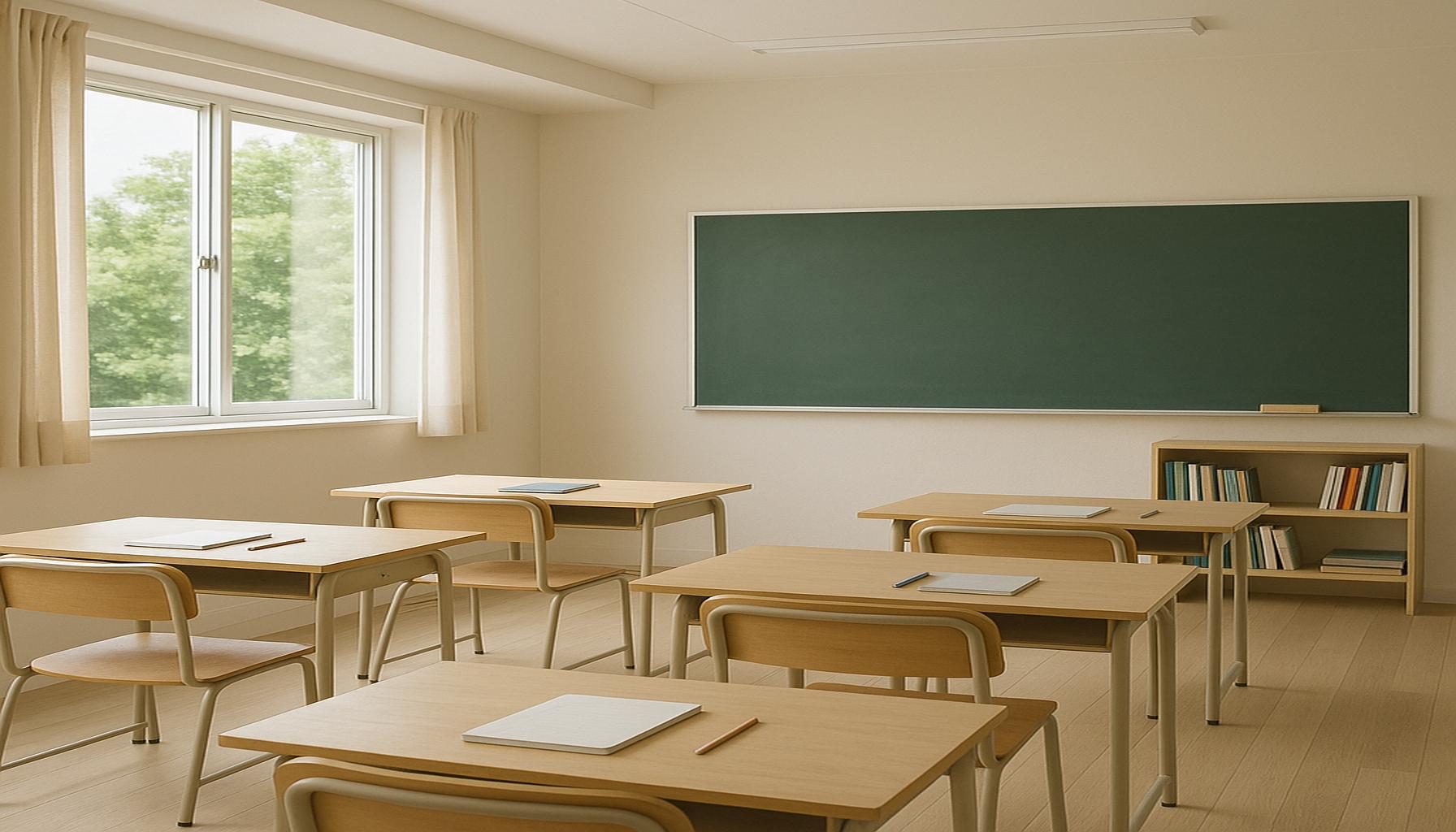Clarity and Minimalism in Education: How an Organized Environment Can Enhance Learning

Unlocking the Potential of Learning Environments
The significance of an organized learning environment cannot be overemphasized. Research increasingly shows that clarity and minimalism can play a pivotal role in educational settings. As schools and educators work to adapt to the unique challenges of modern-day learning, the shift towards streamlined spaces is transforming the way students engage with their studies.
Why Focus on Clarity and Minimalism?
In a world filled with notifications, distractions, and overwhelming sensory input, simplicity becomes essential. Creating a well-organized educational space can:
- Reduce Stress: Clutter can create feelings of chaos, leading to heightened anxiety. Educational psychologists suggest that a tidy environment fosters a sense of control, allowing students to feel at ease and more prepared to tackle their curricula.
- Improve Focus: Research indicates that a clear workspace aids in promoting concentration and reduces cognitive overload. Students in clean, uncluttered classrooms experience fewer distractions, enabling them to focus on their lessons and assignments.
- Encourage Creativity: With minimal distractions, pupils often find it easier to think outside the box and explore innovative solutions. A thoughtfully designed environment that emphasizes simplicity can spark curiosity and foster creative thinking among students.
With a growing recognition of these benefits, schools and educators are exploring innovative practices that incorporate clarity and minimalism. For example, consider the impact of creating visually appealing classrooms with limited decor that still maintains an engaging atmosphere. Such changes have been shown to lead to:
- Better Academic Performance: Studies suggest that students thrive in less chaotic environments, scoring higher on assessments and exhibiting improved retention of information due to the reduced distraction.
- Enhanced Collaboration: Well-organized spaces facilitate team dynamics. In classrooms designed with collaborative learning in mind, students can work together more effectively when their environment supports open communication.
- Holistic Well-being: A clean, organized space contributes to mental clarity and emotional stability. An uncluttered environment can enhance mindfulness, helping students manage stress and cultivate resilience in the face of academic challenges.
This exploration into how clarity and minimalism can enhance learning experiences is part of a broader educational movement towards designing environments that optimize student engagement. From practical adjustments like the arrangement of desks to transformative philosophies around open, flexible learning areas, education is entering a new era. These carefully designed spaces aim not only to facilitate learning but also to cultivate an environment that promotes overall student success.
As schools across the United States begin to embrace these principles, it will be important for educators and policymakers to continue investigating how these adjustments can lead to meaningful improvements in student outcomes. The future of learning may very well hinge on understanding the power of our environments.
DISCOVER MORE: Click here to learn how minimalist organization can transform your life
Transforming Educational Spaces for Enhanced Learning
Implementing principles of clarity and minimalism in educational environments is more than a trend; it represents a fundamental shift in teaching practices and methodologies. The traditional classroom setup often overwhelms students with excessive decor and distractions, which can detract from their learning experience. By consciously designing educational spaces that prioritize simplicity, schools can lay the groundwork for a more conducive atmosphere for students to thrive academically and emotionally.
The Importance of Organized Spaces
A well-organized environment can significantly influence a student’s ability to absorb and process information. Research from educational institutions highlights several advantages that come with streamlined, minimalist spaces:
- Enhanced Organization: Classrooms that are decluttered and logically arranged help students quickly locate materials and resources, fostering independence and responsibility in their learning. For example, having clearly labeled shelves for supplies promotes self-directed learning, allowing students to engage meaningfully without the constant need for teacher intervention.
- Increased Engagement: A minimalist environment encourages students to interact with learning materials rather than being visually distracted. When students are immersed in an uncluttered space filled with thoughtfully selected learning tools, they become more engaged with their coursework and less likely to disengage due to environmental stressors.
- Facilitation of Routine: Establishing a consistent structure within the classroom allows students to anticipate and prepare for various activities. A clear layout that minimizes confusion can help reduce anxiety, particularly for students with learning disabilities or those who thrive on routine, promoting a smoother academic experience.
Further research indicates that clarity and minimalism create a fertile ground for cognitive development. In environments that integrate these principles, students tend to exhibit:
- Improved Retention: With fewer stimuli to distract them, students can better focus on learning concepts, leading to improved retention of information. A study from the University of California revealed that students in minimalist classrooms scored significantly higher on retention tests compared to those in more chaotic environments.
- Better Communication Skills: In thoughtfully designed learning spaces that promote collaboration, students find it easier to communicate their ideas and work together effectively. Through project-based learning initiatives, teachers can utilize clear space to facilitate group work, encouraging students to develop essential interpersonal skills.
The movement towards clarity and minimalism in education also extends beyond physical spaces into pedagogical approaches. Teachers are increasingly employing technology, such as interactive whiteboards and educational apps, that support a minimalist philosophy while enhancing the learning experience. Streamlined digital tools can reduce the cognitive load on students and allow them to engage more deeply with content, which is especially relevant in today’s tech-driven education landscape.
As educational institutions continue to adapt, understanding the relationship between an organized, calm environment and improved learning outcomes will pave the way for innovative practices. By examining how clarity and minimalism influence learning, educators can unlock new pathways for student success and well-being.
Certainly! Continuing with the discussion on “Clarity and Minimalism in Education: How an Organized Environment Can Enhance Learning,” let’s delve deeper into the psychological and emotional benefits that an organized learning environment can offer.One of the most significant aspects of minimalism in educational spaces is its ability to reduce distractions. When a classroom boasts clean lines and a simple color palette, students can focus better on the task at hand. Studies show that environments cluttered with unnecessary items can lead to cognitive overload, hindering the ability to process information efficiently. With less visual noise, students can direct their attention where it truly matters—on their learning experience.Moreover, an organized space often reflects a sense of calmness and clarity that can significantly lower stress levels in students. Educational institutions that adopt minimalist principles can create atmospheres that feel more inviting and less intimidating. For instance, comfortable seating layouts and well-planned areas for collaboration allow learners to engage more freely and expressively. Such settings promote a positive emotional climate, fostering stronger relationships among peers and abilities to communicate effectively.Incorporating minimalist design principles not only facilitates an organized physical space but also cultivates a mindset geared toward sustainable learning. By emphasizing the essentials and removing superfluous items, students learn to prioritize their goals and manage their time effectively. Thus, minimalism becomes an educational tool, steering learners toward self-discipline and personal responsibility—qualities that are invaluable both in and out of the classroom.Furthermore, engaging with a minimalist environment can prompt educators to adopt similar pedagogical strategies that focus on clarity. This approach encourages teaching methods that prioritize understanding over memorization, allowing students to grasp concepts more thoroughly. As we explore how minimalism influences educational outcomes, it’s crucial to consider how such practices can prepare students for real-world challenges by fostering critical thinking and creativity.In summary, the emphasis on clarity and minimalism in education has profound implications for learning experiences. By recognizing the value of an organized environment, both students and educators can harness its benefits to create a more productive and enriching educational atmosphere.
DIVE DEEPER: Click here to uncover the beauty of minimalism
Creating a Mindful Learning Experience
As educational spaces evolve to embrace the principles of clarity and minimalism, the impact on student learning transcends mere aesthetics. The textures of learning become deeply intertwined with mindfulness, encouraging a holistic approach that nurtures not just academic performance but emotional intelligence as well. More educators are discovering that a thoughtfully curated classroom environment sets the stage for a transformative educational experience.
Mindfulness and Its Educational Implications
Research increasingly supports the idea that a clear and minimalist educational environment promotes mindfulness among students. Mindfulness, defined as the practice of being present and fully engaged in the moment, can significantly enhance focus and minimize distractions. By reducing clutter in the classroom, educators can cultivate a serene atmosphere that encourages students to practice mindfulness during their lessons.
- Calm and Focused Atmosphere: Studies reveal that uncluttered spaces foster calmness, which is essential for effective learning. For instance, the University of Minnesota found that students working in minimalistic environments reported lower stress levels compared to those in more cluttered classrooms. This reduced anxiety can lead to heightened concentration, thereby enhancing students’ understanding of complex subjects.
- Engagement with the Learning Process: A minimalist approach encourages students to focus on their individual learning processes rather than becoming entangled in sensory overload. This focused engagement allows students to delve deeper into their studies, making connections between ideas and applying knowledge more effectively. An example of this can be seen in classrooms that employ nature-inspired designs, which eliminate distractions and draw students’ attention to their coursework.
- Promotion of Critical Thinking: Simplified surroundings allow for freer thought processes. When unnecessary detail is stripped away, students can engage in critical thinking more effectively. Research from Stanford University indicates that students in minimalist environments are better equipped to analyze information, generate innovative solutions, and think creatively about problems.
Moreover, the integration of social and emotional learning (SEL) into minimalist educational spaces reinforces the connections between clarity and students’ emotional health. A classroom layout that allows for flexible seating arrangements fosters collaboration while promoting a sense of community. In such an environment, peer interactions are less hindered by physical barriers, enabling students to communicate openly and collaboratively.
The Role of Nature in Minimalistic Learning Spaces
Another critical aspect in the discussion of clarity and minimalism lies in the design element that incorporates nature. The trend of indoor plants and natural lighting in classrooms lends itself not only to aesthetics but also to improved cognitive function. According to recent studies conducted by experts at the University of Exeter, students exposed to natural elements in their learning environments show productivity levels increased by 15%. Furthermore, the mere presence of greenery in classrooms supports mental well-being and reduces stress levels.
- Integrating Nature into Learning: Schools can vastly benefit by bringing elements of nature indoors. Strategies like having classrooms with large windows or a garden space where students can interact with plants can enhance their connection to the environment. This organic approach to learning does not just beautify a classroom but cultivates a sense of responsibility and awareness about ecological practices.
- Biophilic Design: The incorporation of biophilic design principles in educational settings invites students to learn in spaces that resonate with their innate connection to nature. Such design includes the use of natural materials, patterns reflective of nature, and ample natural light. These elements have been noted to boost creativity and problem-solving skills, essential attributes in today’s learning contexts.
In summary, the fusion of clarity, minimalism, and mindfulness in educational settings offers a dynamic path toward reshaping how learning occurs. By reassessing the environments in which students engage with knowledge, educators can unveil significant opportunities for enhanced academic performance and personal growth.
EXPLORE MORE: Click here to delve deeper
Conclusion: Embracing Clarity and Minimalism in Education
In an era where educational interventions are continuously evolving, the importance of clarity and minimalism cannot be overstated. As we have explored, the deliberate design of learning environments significantly influences student engagement, mental well-being, and academic performance. By prioritizing uncluttered, organized spaces, educators create a backdrop conducive to the mindful practice of learning. This focus on mindfulness allows students to immerse themselves fully in their educational journeys, fostering deeper connections with the material.
The integration of nature and biophilic design into classrooms further enhances this environment, offering tangible benefits such as improved cognitive function and reduced stress levels. The findings from various studies underscore the incredible potential for enhanced focus, critical thinking, and emotional intelligence that emerges from these innovative approaches. Importantly, as teachers move toward incorporating these principles, they are not just shaping academic outcomes but also nurturing future generations that are more aware, collaborative, and environmentally conscious.
As we consider the future of education, the adoption of clarity and minimalism stands out as a transformative movement—one that promises to cultivate not just knowledge, but holistic growth. In pursuing these practices, educators and school administrators are invited to rethink traditional approaches and explore new avenues that prioritize a calm, engaging, and inspiring learning environment. The journey toward achieving effective, meaningful education begins with the spaces where learning occurs, led by the principles of clarity and minimalism.


